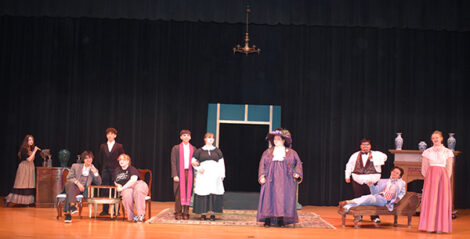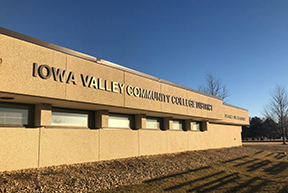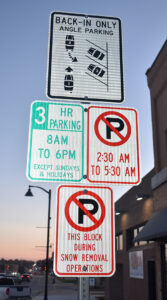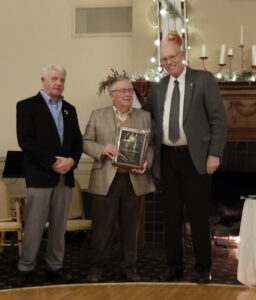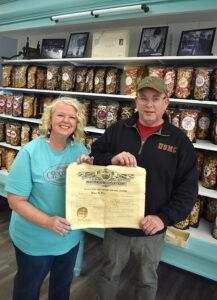Board of Adjustment grants special use permit for McFarland solar project
A saga that began almost a year ago finally concluded with a favorable outcome for McFarland Clinic as the city of Marshalltown’s Board of Adjustment voted unanimously to grant a special use permit for the healthcare facility’s large scale solar project after a public hearing at city hall on Tuesday evening.
The confusion began last May when the city council, in response to complaints about a pair of arrays in residential areas, enacted a moratorium on all new ground mounted solar arrays in Marshalltown, which placed a project McFarland had already put into motion in limbo. The council then passed a new ordinance banning ground mounted solar panels on all land other than parcels zoned Industrial or Agricultural within city limits before later reversing course and allowing such arrays on areas zoned as Public Institutions, including McFarland Clinic, with a special use permit.
Just last week, after urging from McFarland Executive Director Deb Wollam and Executive Director of Facilities Management Ron Frantzen, the council passed another modification to the ordinance increasing the allowable height of panels from six to 10 feet. With the regulatory obstacles removed, the project cleared its final hurdle with the approval of the special use permit on Tuesday.
Assistant Housing and Community Development Director Clayton Ender provided some background on the project as the discussion began, noting that it would include both ground mounted panels and some over water. The Planning and Zoning Commission had already recommended approval of the permit application, and Ender said there would be security fencing surrounding the entire facility and landscape buffering on the north end that would screen from any view on public right-of-way. A decommissioning plan would also require McFarland to dismantle and remove the array within 12 months if operations are ceased.
In response to an early question from Board of Adjustment Chairwoman Kelli Thurston, Ender clarified that McFarland was not requesting a variance of any kind, but simply a special use permit not requiring the organization to prove any unique circumstances. He also explained which properties in Marshalltown are zoned as public institutions — prominent examples include the MCC campus, MCSD buildings and the UnityPoint Hospital.
Board of Adjustment member Mark Eaton told Ender he was “confused” by why Iowa River Hospice, which is located just to the north of McFarland, is zoned residential and mixed use as opposed to public institutions. Eaton said the PI designation was made for McFarland and didn’t exist when they built the clinic there, and fellow BOA member David Schulze commented that there was “a lot of spot zoning” in the area.
Eaton brought P&Z Commission Chairman Jon Boston to the speaking podium to explain how the PI zoning designation is defined and applied.
“We don’t have an exact definition, I don’t believe, in the zoning ordinance, but what happens is we rewrote the entire code two years ago, roughly. We went through the city and picked out those areas that we wanted to classify as public institutional, and that was based on the consultant that was rewriting the code,” Boston said. “We made all the schools, the hospital, the college, I believe the city maintenance facility on East Main Street, so basically any government properties, school system and medical sites were all rezoned to public institutional.”
Eaton also asked about the MCSD’s since halted plan to install a ground mounted array on land near Bicentennial Park, and Boston said it was zoned recreational and not public institutional. As a result, he felt it would have had a difficult time garnering approval had it proceeded.
Boston added that McFarland was at one time zoned as mixed use before the commission changed its mind on the appropriateness of such a designation, and Eaton inquired about the approval process for the YMCA/YWCA’s solar project on 18th Avenue. Boston said the special use permit system was a way to avoid the mistakes that allowed the installations of the aforementioned ground arrays in residential areas, and he also noted that the commission had received “outdated” information when initially setting the height restriction for panels at six feet.
After Ender returned to the podium to explain the stormwater retention on the property and Wollam told Eaton that all of the parking lines had been re-striped, Thurston opened up the floor for public comments. First Ward City Councilor Mike Ladehoff expressed his support for the project as an example of development and investment in the community, and he felt it met all of the criteria for approval.
“It’s not just a blind shot (and) anyone can do it. The concerns over being too close to residential or anything like that, this has that in spades. It’s totally away from everybody else, and I think it’d be a great project,” Ladehoff said.
He added that other projects at MCC and the hospital were likely to happen in the near future. Dave Grieve called solar “interesting” and said it would change a heat signature to a dark one year round, questioning whether it was completely green. He suggested putting the panels over the parking lot to protect cars, and he also expressed concern about what would happen in 25 to 30 years when the panels were no longer usable.
“I’ve got a building right now that has lead and asbestos that I have to deal with. Who’s gonna have to deal with toxic cleanup on that 30 years from now, and will the city get stuck with it? That’s my question,” Grieve said.
Thurston repeated Ender’s earlier explanation that McFarland would be responsible for dismantling the array within 12 months if it was no longer operational. Frantzen then stepped forward and told the board the array would reduce the clinic’s utility costs by almost $200,000 a year and doubted they would walk away from it anytime soon.
“This is something that’s gonna be ongoing, and it’s upgradable as we need to,” he said. “I guess for the main part, it is on McFarland Clinic’s property. We’re a good steward in the community. We do the best to help support the community in everything we do, and I would look at that as another strong commitment to the city of Marshalltown.”
He felt it was a sensible use for the area in question, which he described as “unbuildable” due to its slope. As the conversation shifted back to the board, Eaton wondered if the array left enough room for LaFrentz Lane to go east all the way from Center Street to 12th Avenue.
“No it does not, and there was subdivision that occurred that LaFrentz is not supposed to be going east-west any further. As I have been advised by our public works director, LaFrentz will terminate in the hammerhead turnaround, and that will be the end of it,” Ender said.
Before making a motion for approval, Schulze commented that he wasn’t in favor of ground-mounted solar within city limits, but he understood it as “the wave of the future” with more similar projects on the horizon. Ultimately, he commented, the board’s job was to determine whether the McFarland project met the parameters of the city’s current regulations regardless of their personal feelings on the matter. With a second from Eaton, it passed by a unanimous 4-0 vote with Tammie Engle absent.
According to Wollam, the array will include over 2,000 ground mounted solar panels installed on the southern third of the clinic property at 421 E. Merle Hibbs Blvd. She said she was appreciative of Marshalltown Area Chamber of Commerce President/CEO John Hall for his advocacy on the project, City Administrator Carol Webb, Mayor Joel Greer, Ladehoff, the city council and the P&Z Commission.
“It is a very important project for our clinic. It will take us to net zero. That’s a couple hundred grand a year in savings,” she said. “Our clinic made a huge investment in this community in 2019 when we embarked on (building) the new clinic, and we have appreciated the city’s support. But projects like this are not going to happen without our city’s support. We’re very excited to be here on Feb. 18 and be able to order those panels tomorrow.”
Wollam and Frantzen plan to move quickly on ordering the panels with intentions to have them installed by the summer and fully operational by October or November.
In other business, the board:
• Approved a variance request from Jose Socorro Carrera Cervantes at 402 Woodbury St. by a 3-1 vote, with Eaton opposed.
——
Contact Robert Maharry
at 641-753-6611 ext. 255 or
rmaharry@timesrepublican.com.
- T-R PHOTO BY ROBERT MAHARRY — From left to right, Board of Adjustment members Kelli Thurston, David Schulze, Adrian Sanchez and Mark Eaton look on during a hearing about the McFarland Clinic solar project on Tuesday evening.
- PROVIDED GRAPHIC — A rendering provided to the Marshalltown Board of Adjustment shows a proposed 16-row solar array with over 2,000 panels on the southern third of the McFarland Clinic property at 421 E. Merle Hibbs Blvd. On Tuesday night, the board voted 4-0 to grant McFarland a special use permit for the project.



